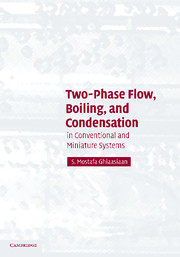Book contents
- Frontmatter
- Contents
- Preface
- Frequently Used Notation
- TWO-PHASE FLOW, BOILING AND CONDENSATION IN CONVENTIONAL AND MINIATURE SYSTEMS
- PART ONE TWO-PHASE FLOW
- PART TWO BOILING AND CONDENSATION
- 11 Pool Boiling
- 12 Flow Boiling
- 13 Critical Heat Flux and Post-CHF Heat Transfer in Flow Boiling
- 14 Flow Boiling and CHF in Small Passages
- 15 Fundamentals of Condensation
- 16 Internal-Flow Condensation and Condensation on Liquid Jets and Droplets
- 17 Choking in Two-Phase Flow
- APPENDIX A Thermodynamic Properties of Saturated Water and Steam
- APPENDIX B Transport Properties of Saturated Water and Steam
- APPENDIX C Thermodynamic Properties of Saturated Liquid and Vapor for Selected Refrigerants
- APPENDIX D Properties of Selected Ideal Gases at 1 Atmosphere
- APPENDIX E Binary Diffusion Coefficients of Selected Gases in Air at 1 Atmosphere
- APPENDIX F Henry's Constant of Dilute Aqueous Solutions of Selected Substances at Moderate Pressures
- APPENDIX G Diffusion Coefficients of Selected Substances in Water at Infinite Dilution at 25°C
- APPENDIX H Lennard–Jones Potential Model Constants for Selected Molecules
- APPENDIX I Collision Integrates for the Lennard–Jones Potential Model
- APPENDIX J Physical Constants
- APPENDIX K Unit Conversions
- References
- Index
15 - Fundamentals of Condensation
- Frontmatter
- Contents
- Preface
- Frequently Used Notation
- TWO-PHASE FLOW, BOILING AND CONDENSATION IN CONVENTIONAL AND MINIATURE SYSTEMS
- PART ONE TWO-PHASE FLOW
- PART TWO BOILING AND CONDENSATION
- 11 Pool Boiling
- 12 Flow Boiling
- 13 Critical Heat Flux and Post-CHF Heat Transfer in Flow Boiling
- 14 Flow Boiling and CHF in Small Passages
- 15 Fundamentals of Condensation
- 16 Internal-Flow Condensation and Condensation on Liquid Jets and Droplets
- 17 Choking in Two-Phase Flow
- APPENDIX A Thermodynamic Properties of Saturated Water and Steam
- APPENDIX B Transport Properties of Saturated Water and Steam
- APPENDIX C Thermodynamic Properties of Saturated Liquid and Vapor for Selected Refrigerants
- APPENDIX D Properties of Selected Ideal Gases at 1 Atmosphere
- APPENDIX E Binary Diffusion Coefficients of Selected Gases in Air at 1 Atmosphere
- APPENDIX F Henry's Constant of Dilute Aqueous Solutions of Selected Substances at Moderate Pressures
- APPENDIX G Diffusion Coefficients of Selected Substances in Water at Infinite Dilution at 25°C
- APPENDIX H Lennard–Jones Potential Model Constants for Selected Molecules
- APPENDIX I Collision Integrates for the Lennard–Jones Potential Model
- APPENDIX J Physical Constants
- APPENDIX K Unit Conversions
- References
- Index
Summary
Basic Processes in Condensation
Condensation is a process in which the removal of heat from a system causes a vapor to convert into liquid. Condensation plays an important role in nature, where it is a crucial component of the water cycle, and in industry. Condensation processes are numerous, taking place in a multitude of situations. In view of their diversity, a classification of condensation processes is helpful. Classification can be based on various factors, including the following:
Mode of condensation: homogeneous, dropwise, film, or direct contact.
Conditions of the vapor: single-component, multicomponent with all components condensable, multicomponent including noncondensable component(s), etc.
System geometry: plane surface, external, internal, etc.
There are of course overlaps among the categories from different classification methods. Classification based on mode of condensation is probably the most useful, and modes of condensation are now described.
Homogeneous Condensation
Homogeneous condensation can happen when vapor is sufficiently cooled below its saturation temperature to induce droplet nucleation, it may be caused by mixing of two vapor streams at different temperatures, radiative cooling of vapor–noncondensable mixtures (fog formation in the atmosphere), or sudden depressurization of a vapor. In fact, cloud formation in the atmosphere is a result of adiabatic expansion of warm and humid air masses that rise and cool.
- Type
- Chapter
- Information
- Two-Phase Flow, Boiling, and CondensationIn Conventional and Miniature Systems, pp. 436 - 461Publisher: Cambridge University PressPrint publication year: 2007



